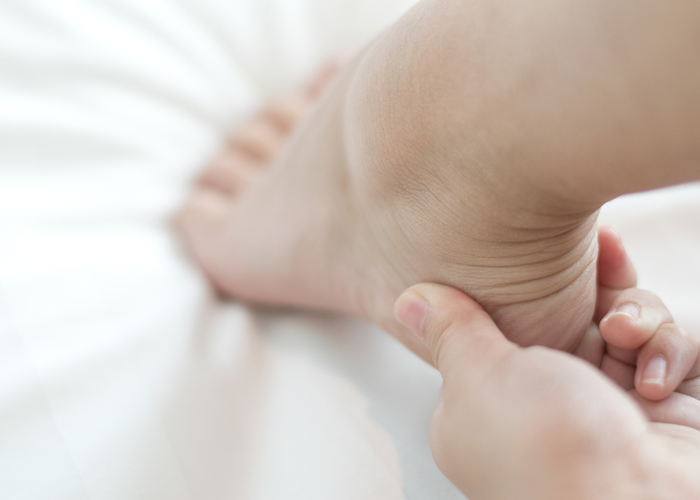
At a glance:
- Sever’s disease is a common cause of heel pain in children and adolescents
- It is caused by by stress placed on the Achilles tendon leading to the irritation or damage of the growth plate in the heel, which in turn leads to inflammation and pain
- Sever’s disease is most common in children during puberty as they undergo growth spurts
- Sever’s disease is what is known as a self-limiting condition. This means that it will typically go away as the child stops growing
- There is no “cure” for Sever’s disease aside from finishing growing, but there are a number of treatment options available that may limit symptoms and help children live an active life
What is Sever’s Disease?
Sever’s disease, also known as calcaneal apophysitis, is the most common cause of heel pain in physically active children and adolescents. It is a form of bone injury in the heel, in which the growth plate to which the Achilles tendon is attached becomes inflamed and sore.
A growth plate is a layer of cartilage near the end of a bone. It is the area where most bone growth happens and, as it is softer than bone, is far more likely to suffer injury through repeated stress.
The condition most commonly occurs before the heel finishes growing and hardens, so is far more likely to develop during growth spurts. For boys, growth spurts usually occur between the ages of 10 and 15. Girls typically have growth spurts a little earlier than boys, so are more likely to develop Sever’s disease between the ages of eight and 13.
Boys appear to be slightly more likely to develop Sever’s disease than girls. This may be because young boys are more likely to take part in high impact physical activities such as playing sports or highly physical schoolyard games.
Although it is rare, some people may develop Sever’s disease in late adolescence or the teenage years.
Symptoms of Sever’s Disease
Sever’s disease may affect one or both heels and may present with symptoms such as:
- Pain at the back of the heel that may radiate to the sides of the heel
- Heel pain and limping after running
- Difficulty or pain when walking
- Stiffness or pain in the feet upon waking in the morning
- Red or swollen heels
- Walking on tiptoes to avoid using the heel
The symptoms of Sever’s disease typically worsen during physical activity and subside with rest.
For advice on how to treat their pain, schedule an appointment with a podiatrist , physiotherapist or doctor .
What Causes Sever’s Disease?
Bones in the heel and leg typically grow faster than the muscles. During a growth spurt this may cause a tightness or stretching in the muscles or tendons. As the heel is one of the first parts of the body to grow to full size and is also placed under a greater deal of stress than most of the rest of the body, it is especially prone to injury during these growth spurts.
The Achilles tendon connects the heel bone to the muscles at the back of the calf. During a growth spurt, this already tight tendon may become stretched or stressed. This repetitive stress in turn may cause damage or irritation to the growth plate in the heel, leading to inflammation and pain.
While there is no identifiable or exact cause of the development of Sever’s disease, there are a number of risk factors that may increase a child's chances of developing the condition, including:
- Activities that involve running and jumping, such as sports and games
- Standing still for long periods of time may place increased pressure on the heel
- Wearing poorly fitted or inappropriate shoes, or shoes that lack support and cushioning
- Excessive physical activity
- Children with flat feet appear to be slightly more prone to developing Sever’s disease
- Being overweight or obese
- Being heavy due to height or build
Treatment for Sever’s Disease
Sever’s disease is what is known as a “self-limiting” condition. What this means is that the symptoms are likely to diminish over time, or in this case, as the child stops growing. During puberty, treatment may be used to ease symptoms and help children maintain regular activities.
There is no definitive treatment for Sever’s disease, but a doctor, physiotherapist or podiatrist may recommend a number of options, including:
- Rest and a temporary respite from the activity that aggravated the heel pain
- Use of ice packs to reduce inflammation and pain
- Calf and foot stretches to help free up the Achilles tendon
- Calf strengthening to increase the load tolerance of the calf and Achilles tendon to exercise
- Wearing gel heel pads, cushioned insoles or orthotics in their shoes
- Wearing well fitted, comfortable shoes that offer good heel and arch support
If your child has sore heels and sometimes finds it difficult to walk or play, they may be suffering from Sever's disease. The fastest and easiest way to make an appointment with healthcare professionals is to search and book online with MyHealth1st.